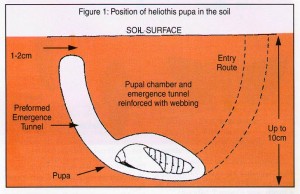Cultivation affects arthropods that dwell in the soil for all or part of their life cycle. When appropriately timed with the life cycle stage, it can be used to directly control insect pest populations.
An example is pupae busting, where cultivation is used to destroy the exit holes of Helicoverpa armigera moths after pupation. A component of the resistance management plan in cotton production, it is normally done post-harvest and before overwintering pupae are due to emerge as moths. Cultivation to a depth of 10 cm is sufficient to destroy exit tunnels.
Cultivation can also:
- Reduce some soil dwelling insects (e.g. cockchafers) by exposing them to adverse environmental conditions including birds and other wild life.
- Restrict movement of crawling insects into the field from other areas by creating a barrier of cultivated soil around the paddock.
- Lower the risk of slugs and snails
Stubble retention favours the increase of some pests, such as bronzed field beetles, weevils, and slugs and snails. High stubble levels on the soil surface can also promote some soil insects due to a food source but this can also mean that pests continue feeding on the stubble instead of germinating crops. Where stubble retention leads to high populations of insect pests that impact on following crops, stubble may need to managed by burning, baling, grazing, or incorporating (via cultivation).
Minimum or zero till can also result in a changing pest complex with the increase and survival of some predatory insects and earthworms.

